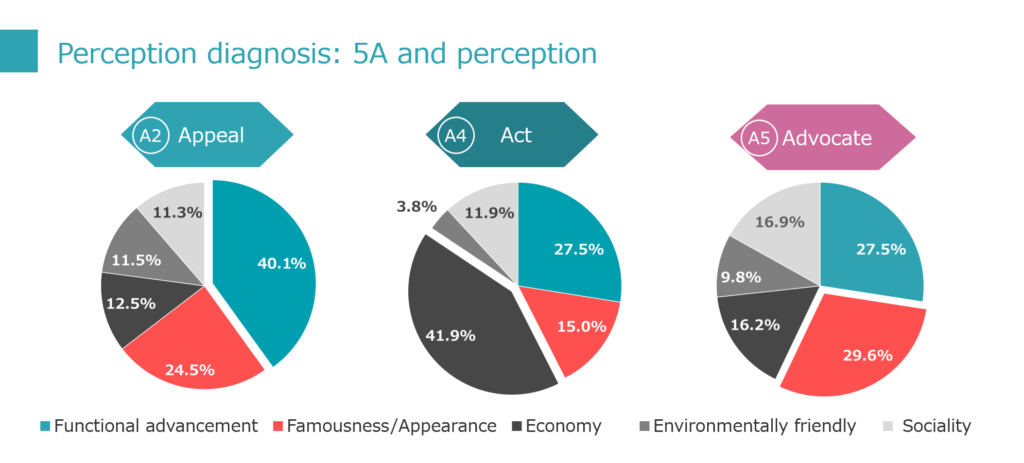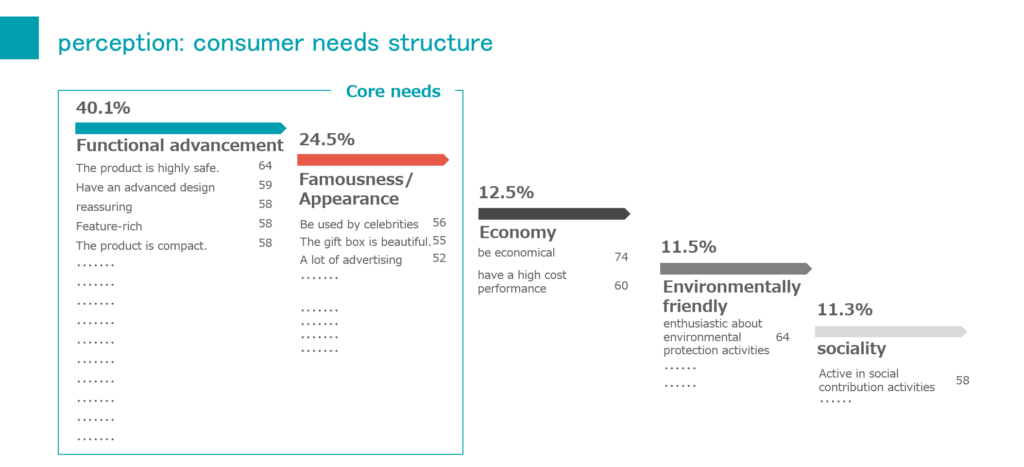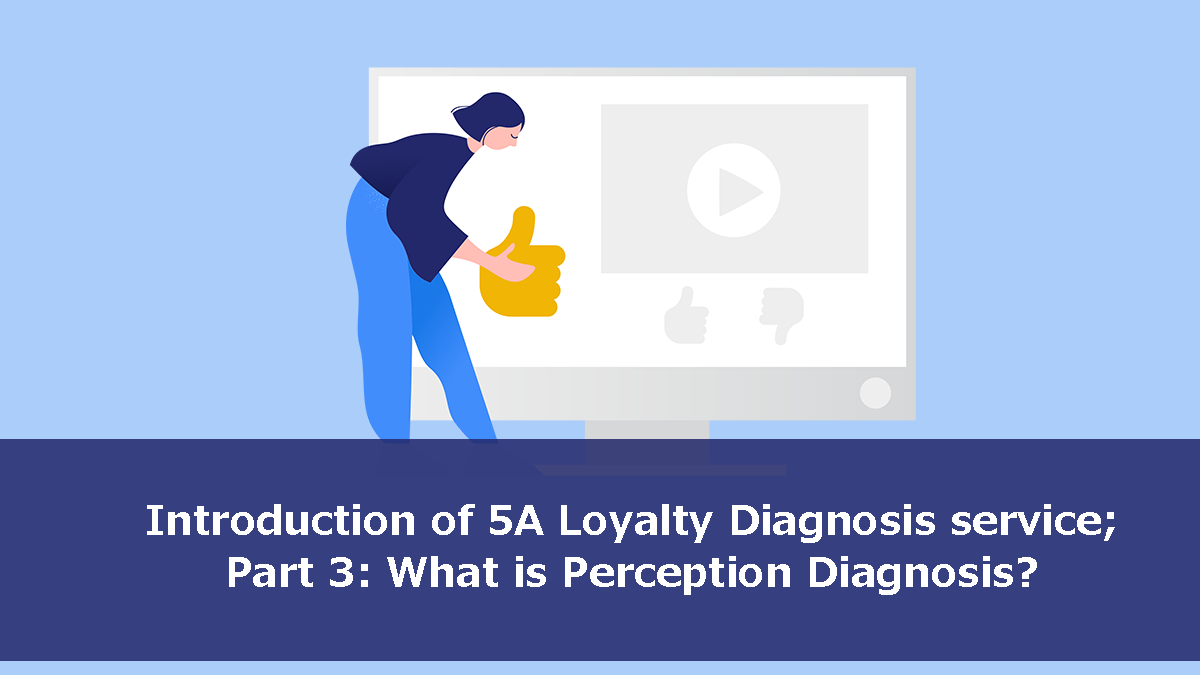This article introduces the “5ALoyalty Diagnosis” service, which allows you to engage in loyalty marketing based on the original indicators proposed by Philip Kotler, the “father of modern marketing”.
This is a five-part series on why loyalty marketing is needed now, and the purpose and benefits of the service. In this third series, we will explain Perception Diagnosis, the second module of the “5A Loyalty Diagnosis”.

What is Perception?
Perception Diagnosis is our original new analysis method that incorporates Perception Analysis into the 5A scheme. Perception analysis itself is based on Perception Preference Analysis (PPA), developed by Professor Emeritus Glenn L. Urban of the Massachusetts Institute of Technology, and combined with 5A, it has created its own method of perception diagnosis.
First of all, what is “perception”? When discussing marketing, you might consider strategies for positioning a particular product and how to create positioning differences. In fact, the term “positioning” is said to be more properly expressed as “perception” in marketing terminology. Positioning is the noun form of the verb to position, which means that it is correct to describe positioning as the strategic intent of how a product is “presented” rather than how it is “seen”. Therefore, when referring to how a product is viewed, it is correct to speak of perception, which means perception or awareness, rather than positioning.
Perception Analysis Methods
Perception analysis is a method of identifying the differences between one’s own brand and a competitor’s brand. The first step in the analysis process is to analyze the major needs from the customer’s perspective in the market under study. Rather than asking customers to tell us what needs they have, we use statistical analysis to identify multiple needs that are required in the target market. In markets with simple competitive structures, the number of needs tends to be small; in markets with complex competitive structures, the number of needs tends to be large. Suppose, for example, that the first factor of that need is “economic efficiency” and the second factor is “advanced. Then it is not easy to conclude that economic efficiency is the most important factor in this market. The first factor extracted as the axis is the factor that best explains the difference in that market, and the second factor is the one that is explained next. What is important from a marketing perspective here is that it is not the case that focusing on the first factor is enough to create a product that will sell or be recommended. This analysis method extracts multiple factors that make up the target market and investigates the degree of influence on each of the A2 (appeal), A4 (action), and A5 (advocate) factors that make up the 5As explained in the previous sections.

The results show that Axis 1 is important to get people to like the product=Appeal, but Axis 3 is important to get people to actually buy it, while Axis 2 is important to get people to advocate it. In many of the studies we have conducted, the key factors influencing each appeal, action, and advocate have been the same in some cases and different in others. This means that the market itself is a complex structure.
What Perception Diagnostics can do
We will further analyze the market with a small number of factors and needs, but we can also learn what exactly each of these needs refers to in terms of relationships, including detailed survey items. For example, if there is a need for “luxury,” there are many possible interpretations of what exactly luxury means. It may indicate “the product seems expensive,” or it may indicate a positive state of being “worth more than the price.” Perhaps it may even lead to an “old-fashioned” image.

Perception analysis is thus a method of extracting the major needs of the market that bind them together from detailed word studies, and analyzing the extent to which each is linked to appeals, actions, and advocates. We then incorporated into this perception diagnosis a quantitative analysis method to determine which of the multiple needs for A2, A4, and A5, respectively, is the most desirable. This technique was originally used to forecast sales prior to the launch of a new product. It allows for very accurate, quantitative analysis. For example, it is possible to conduct detailed and additional analysis of like how much impact on sales and market share will there be when one of the factors, economic efficiency, is improved, or How much the number of users will increase when the luxury factor is strengthened for a specific target.
If the 5A diagnosis we discussed in the last article captures the reality of loyalty itself, the Perception Diagnosis is a tool that can be provided as a quantitative diagnosis to clarify the reasons for loyalty.
(Commentary / transcosmos inc. Tsunehiro Fukushima)
(Images for commentary were edited by our company from “Kotler’s Marketing 4.0″)
Introduction of 5A Loyalty Diagnosis service; Part 1: Getting Started in Building a Loyalty Marketing Strategy(5 part series)
“Introduction of 5A Loyalty Diagnosis service; Part 2: What is 5A Diagnosis?(5 part series)
“Introduction of 5A Loyalty Diagnosis service; Part 3: What is Perception Diagnosis?(5 part series)
“Introduction of 5A Loyalty Diagnosis service; Part 4: What is CX Diagnosis?(5 part series)
“Introduction of 5A Loyalty Diagnosis service; Part 5: Summary(5 part series)
Tsunehiro Fukushima will direct your marketing efforts
At transcosmos, we offer marketing strategy proposals along the 5A concept advocated by Philip Kotler. For actual proposals, Tsunehiro Fukushima, the commentator of this article, will support loyalty marketing optimized for the digital age. Please tell us your company’s concerns.

Tsunehiro Fukushima
Corporate Executive Officer, transcosmos inc.
Director, Japan Marketing Association
After completing graduate studies at Tokyo Institute of Technology, he joined Ajinomoto Co., Inc. He then worked for GE Capital, Mitsubishi Corporation, Gurunavi, Inc., and Medical Data Vision Co., Ltd., where he served as head of big data business and marketing. His areas of expertise include new business and new product development, brand theory, medical business, and loyalty marketing. At transcosmos, he is in charge of marketing-related business development and is the exclusive provider in Japan of the 5A diagnosis introduced in the book “Kotler’s Marketing 4.0”.

